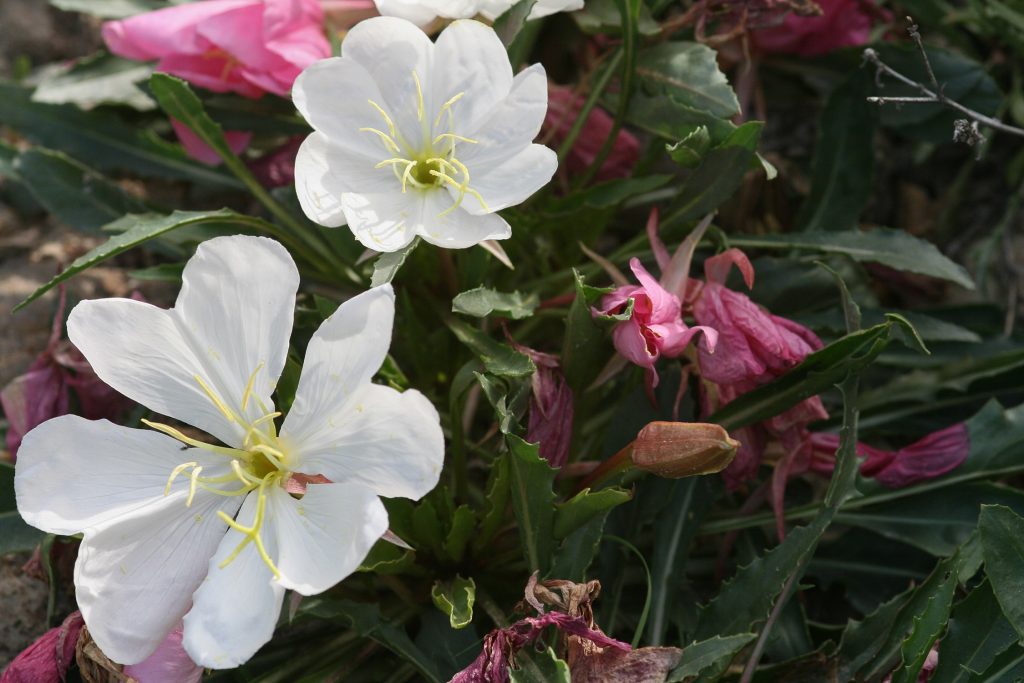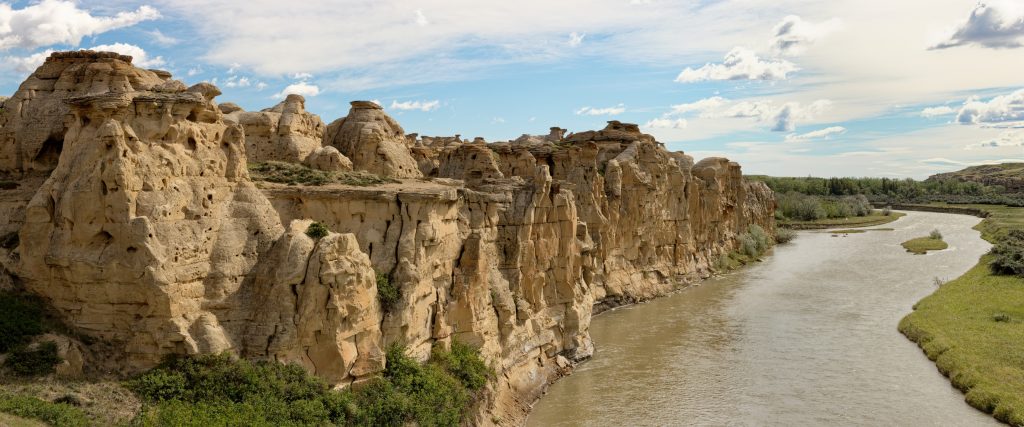Bad But Beautiful

The extensive badlands of Dinosaur Provincial Park are made of highly eroded mudstones and sandstones, deposited long ago when the local environment was much wetter than today. LORNA ALLEN
BY LORNA ALLEN
The Lakota people called them “mako sica,” or “bad lands.” French trappers and traders had the same opinion and called them “les mauvaises terres à traverser” — “bad lands to cross.” Since then, the term “badlands” has stuck. Unusual landforms, extreme temperatures, and a lack of water are typical of the areas where they are found, and contribute to the “badness” of this rugged landscape. However, these marvellously bleak landscapes are beautiful to my eye.
What Makes Badlands Bad?
Badlands are typically found in deep, broad valleys that were cut by tremendous flows of meltwater as the glaciers of the last Ice Age retreated. Today, erosion continues at an astonishing rate — at least astonishing in geologic terms. For example, the badlands in the Red Deer River valley, which are up to 200 metres deep, have been measured to erode between 1–2 cm per year. The result is a shifting, complex pattern of hills, cliffs, and gullies formed through the interplay of water, wind, and bedrock layers.
Badlands form in areas where the bedrock is composed of horizontal layers of sandstones, siltstones, shales, and clays. These layers are technically “rock” but soft enough to easily erode. Different kinds of layers erode at different rates, and this contributes to the creation of characteristic badlands features. For example, if a hard “caprock” lies on top of softer bedrock, the softer layer may erode away under the caprock and voila — a hoodoo.
Sixty-five million years ago or more, erupting volcanoes spewed large amounts of ash that formed thick layers. The ash transformed over the years to become thick layers of bentonitic clays. These layers of clay are often exposed and eroded in Alberta’s badlands, forming what is commonly called “gumbo.” It is soft and porous and has the unusual characteristic of swelling up to eight times its size when wet. Then, when it dries it creates an extensively cracked surface. But beware! Although the crust may look dry, there could be a slick layer under the crust waiting to slip under an unwary footstep.
Water flows are also important in creating badlands features. Spots that channel water eventually erode into gullies and valleys, providing a variety of habitats from exposed slopes to protected corners. If rain sinks into softer rocks and then hits an impervious layer, it creates a seep above it. In the dry environment of badlands, these spots of moisture become little gardens. As a result, there are many surprising finds in the nooks and crannies of this seemingly lifeless terrain.
Red Deer River Badlands

The fragrant blooms of the tufted evening-primrose open at dusk. White at first, they turn pink by the next day as they begin to wither. LORNA ALLEN
Alberta has over 1,300 km2 of badlands; some are localized patches and some are large, impressive expanses. Most of Alberta’s badlands are linked together along the Red Deer River valley, sometimes extending into the steep-sided coulees that branch off the main valley into the prairie. Extensive areas of badlands can be found between Drumheller and Dry Island Buffalo Jump Provincial Park and in Dinosaur Provincial Park. The badlands at Dinosaur Park extend well back from the river and are considered the largest and most spectacular area of badlands in Canada.
The Red Deer River badlands are world-renowned for their fossils, but there is much else of interest as well. Despite this seemingly barren landscape and difficult growing surface, look closely and you might find a few uncommon to rare annuals like Suckley saltbush (Atriplex suckleyi). These plants sprout, bloom, set seed, and die in a very short time. This is one of a number of strategies that plants have developed to survive in a harsh, hot, low-water environment: flower early while there is still soil moisture from the spring melt, set seed, and complete your life cycle before things get too dry. Also look here for the tufted evening-primrose (Oenothera caespitosa), sometimes called the gumbo primrose. Its thick, woody root helps it hang onto the eroding slopes. One or two blooms open at dusk. White at first, they turn pink and begin to wither by the next day, avoiding the drying daytime sun.
May through June is probably the best time to visit these badlands. In some years, the spring blooms can be quite showy. This is the time to look for the purple flowers of tufted milkvetch (Astragalus spatulatus) and the white flowers of plains milkvetch (Astragalus gilviflorus). Both grow in cushions, low to ground — a strategy to conserve water by limiting overall exposure to drying wind and sun. Hoary-aster (Dieteria canescens) is showy, and another plant with a cushion-like growth pattern. This species often plays host to the sagebrush checkerspot butterfly (Chlosyne acastus), whose caterpillar feeds on badland plants like hoary-aster.
On some of the driest and most exposed sites, you might find the brilliant blue blooms of waxleaf beardtongue (Penstemon nitidus). Taking a closer look, you can see that the beardtongue has another of the classic adaptations of dry-land plants: thick leaves with a waxy coating to reduce evaporation. Plains prickly pear (Opuntia polyacantha) is common on the ridges and dry exposed slopes. It too has a waxy coating to reduce water loss, but has gone extreme — the leaves are essentially gone, modified to thorns, and replaced by thickened stems that both store water and carry out the food-producing business of photosynthesis. Although by July the badlands can be dry and crunchy from the summer heat, the hardy prickly pear can be found blooming mid-June into July. Even its lemon-yellow flowers have a waxy coating to prevent water loss.
Look for other splashes of colour. The yellow of Colorado rubber-plant (Hymenoxys richardsonii) can be found where nothing else grows. Scarlet mallow (Sphaeralcea coccinea) is an easy one to recognize — it can form extensive patches of orange, an unusual colour in this environment. Many a dry-environment plant, like longleaf wormwood (Artemisia longifolia), is grey. The light colour helps reflect sunlight and the narrow leaves are less prone to water loss than wide leaves. Looking closely, you can see that the leaves are covered with hairs, which help block the sun and deflect drying winds.
Milk River Badlands

The badlands in Writing-on-Stone Provincial Park feature large sandstone cliffs, quite different from the badlands of Dinosaur Provincial Park. R. SCHNEIDER
Now let’s move south to the badlands along the Milk River, where the landscape is quite different from the Red Deer River badlands. Here we find massive sandstone structures, often carved into large hoodoos, as well as clay flats and narrow ravines with great cliffs. Chemical weathering in the rock provides nooks and crannies and holes for roosts, burrows, or nests for creatures ranging from bees to great horned owls. There is so much to see in these badlands! The cliffs also provide the canvas for some of the most significant rock art in the North American Plains in a sacred area, central to the Blackfoot people.
Wandering the maze of hoodoos at Writing-on-Stone Provincial Park, you will find little patches of flowers. Caprocks are erosion-resistant and give a relatively stable platform for small “gardens” perched atop a hoodoo. Splashes of colour are provided by yellow umbrella-plant (Eriogonum flavum) and Laxmann milkvetch (Astragalus laxmannii). Finding the uncommon blazing star (Mentzelia decapetala) is always a treat. A biennial herb with a prickly rosette of leaves the first year, in year two the blooming stem can get almost a metre tall with beautiful, large, lily-like flowers. Then it sets seed and dies. This plant only needs to hang onto the slope for the two-year life cycle, so it can be found on dry, eroded slopes and banks.
There are so many rare species hidden around the hoodoos, it’s like a treasure hunt. If you look, you should have no trouble finding cock’s-comb cryptantha (Oreocarya glomerata). This is certainly the best place to spot spiny milkvetch (Astragalus kentrophyta), another of the cushion plants, this one rare in Canada. Other rare species that might take a little more searching to locate include: nodding umbrella-plant (Eriogonum cernuum), narrowleaf four-o’clock (Mirabilis linearis), purple three-awn (Aristida purpurea), and green milkweed (Asclepias viridiflora).
Kleskun Hill
Let’s end our brief tour of Alberta’s badlands with Kleskun Hill. Found east of Grande Prairie, these badlands are by far the most northerly. While they are composed of different bedrock, they have a similar look to the Red Deer River badlands. There are even fossils here, including a lizard fossil first found in this area and named after it: Kleskunsaurus grandeprairiensis. (How cool is that?) These badlands are not as extensive as the others, but they are home to some of the classic badlands species. Perhaps most surprisingly, there are patches of blooming cactus this far north. This time, though, rather than the plains prickly pear, it is the brittle prickly pear (Opuntia fragilis). A brief review of distributions shows the population along the Peace River slopes to be the most northerly cactus — anywhere.
Badlands, with their unusual landforms and species that are often uncommon, if not rare, are truly wonderful locations to enjoy and cherish. Not so “bad” after all — just bring lots of water and avoid the gumbo when it rains.
Lorna Allen is a retired biologist. She worked in Alberta’s protected areas for more than 35 years, including working as the Coordinator for Alberta’s Conservation Data Centre. Since retiring, Lorna has co-written, with Linda Kershaw, the Vascular Flora of Alberta: An Illustrated Guide (2020) and is currently working with Linda on a companion volume to the illustrated guide.
This article originally ran in Nature Alberta Magazine – Summer 2023.
